 Founded in 1980 by Frank and Elaine Wrenick |
|
|
Nash Rambler HistoryBy Rob Wagner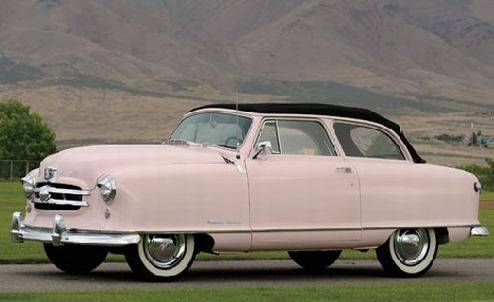 Origins
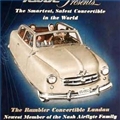 Nash advertises its
Nash Rambler
Landau
convertible in 1951. The Nash Rambler can trace its roots to the
Rambler horseless carriage built by the Thomas B. Jeffery Company in
1902 and produced through 1914. In 1916, Charles Nash bought the
Jeffery Company, renamed the car Nash and created Nash Motors. Nash
merged with kitchen appliance manufacturer Kelvinator Corp. in 1937 to
become the Kenosha, Wis.-based Nash-Kelvinator Corp. Nash advertises its
Nash Rambler
Landau
convertible in 1951. The Nash Rambler can trace its roots to the
Rambler horseless carriage built by the Thomas B. Jeffery Company in
1902 and produced through 1914. In 1916, Charles Nash bought the
Jeffery Company, renamed the car Nash and created Nash Motors. Nash
merged with kitchen appliance manufacturer Kelvinator Corp. in 1937 to
become the Kenosha, Wis.-based Nash-Kelvinator Corp.Postwar Era
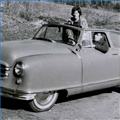 The 1951 Landau
convertible sat on
a
compact 100-inch wheelbase. Nash produced a line of mid-level cars
through 1950, but George Mason recognized there was a glut of large and
very similar cars produced in Detroit. Nash Motors was already at a
disadvantage because it was based in Wisconsin, and material and parts
had to be shipped from Detroit at a greater expense than its rivals. To
survive, Nash sought a different car for buyers. The 1951 Landau
convertible sat on
a
compact 100-inch wheelbase. Nash produced a line of mid-level cars
through 1950, but George Mason recognized there was a glut of large and
very similar cars produced in Detroit. Nash Motors was already at a
disadvantage because it was based in Wisconsin, and material and parts
had to be shipped from Detroit at a greater expense than its rivals. To
survive, Nash sought a different car for buyers.First
Compact Car
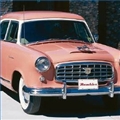 Bright colors were common in the Nash Rambler line. In 1950, Nash introduced the Nash Rambler, the first compact car that was significantly smaller and weighed less than its competitors. It sat on a 100-inch wheelbase that, even by contemporary standards, is short. It was powered by a modest 173-cubic-inch flathead 6-cylinder engine, generating a reasonable 82 horsepower. Rambler Name
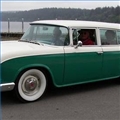 This two-tone 1957
Nash
Rambler
exhibits sharp lines and a contemporary look. The same year that
the
Rambler was introduced, Nash renamed its line of cars to include the
Statesman and Ambassador. The Rambler was originally slated to be the
Diplomat, but Dodge claimed the name for its two-door hardtop. Nash
chose Rambler to honor the original Jeffery Rambler. This two-tone 1957
Nash
Rambler
exhibits sharp lines and a contemporary look. The same year that
the
Rambler was introduced, Nash renamed its line of cars to include the
Statesman and Ambassador. The Rambler was originally slated to be the
Diplomat, but Dodge claimed the name for its two-door hardtop. Nash
chose Rambler to honor the original Jeffery Rambler. European Influence
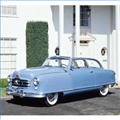 The convertible's
unique
window-frame
construction was not found on Nash's competitors' cars. When American
soldiers returned from Europe following World War II, they brought with
them their appreciation of the small, economical and rather basic
European car. Body styling was based on the concept that form follows
function and that a car, above all, was transportation to get from
Point A to Point B. Nash followed this philosophy but combined the
elements of economical transportation with comforts, like a roomy
interior, to fit American expectations. Nash also used the famed
Italian body stylist Pininfarina as a designer. The convertible's
unique
window-frame
construction was not found on Nash's competitors' cars. When American
soldiers returned from Europe following World War II, they brought with
them their appreciation of the small, economical and rather basic
European car. Body styling was based on the concept that form follows
function and that a car, above all, was transportation to get from
Point A to Point B. Nash followed this philosophy but combined the
elements of economical transportation with comforts, like a roomy
interior, to fit American expectations. Nash also used the famed
Italian body stylist Pininfarina as a designer.High End Compact
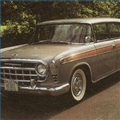 The 1957 Nash
Rambler Rebel was
the last
in the Nash Rambler offerings. Although focused on economy, Nash also
recognized the dangers of being labeled as a cheap car, which would
keep buyers away. To avoid the association, Nash developed the high-end
convertible Landau, which was more in line with its Detroit
counterparts. The 1957 Nash
Rambler Rebel was
the last
in the Nash Rambler offerings. Although focused on economy, Nash also
recognized the dangers of being labeled as a cheap car, which would
keep buyers away. To avoid the association, Nash developed the high-end
convertible Landau, which was more in line with its Detroit
counterparts.Merger
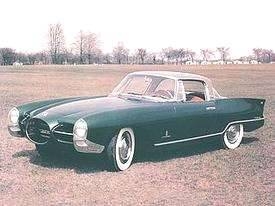 A 1957 Nash Rambler
Palm Beach
concept
car designed by Pininfarina but never mass produced. In 1954, Nash
merged with the Hudson Motor Car Company to become the American Motors
Corporation. Many Nash Ramblers were rebadged as Hudson Ramblers and
shipped to Hudson dealerships. There was no difference between the Nash
and Hudson Ramblers. Nash Ramblers continued, including a new four-door
sedan and four-door station wagon, until 1957 when the Nash Rambler
moniker was finally dropped. A 1957 Nash Rambler
Palm Beach
concept
car designed by Pininfarina but never mass produced. In 1954, Nash
merged with the Hudson Motor Car Company to become the American Motors
Corporation. Many Nash Ramblers were rebadged as Hudson Ramblers and
shipped to Hudson dealerships. There was no difference between the Nash
and Hudson Ramblers. Nash Ramblers continued, including a new four-door
sedan and four-door station wagon, until 1957 when the Nash Rambler
moniker was finally dropped. |